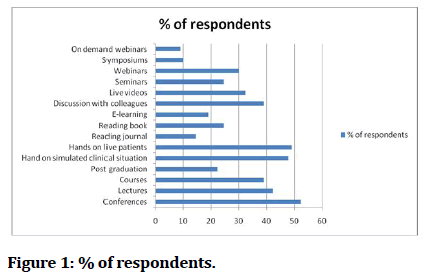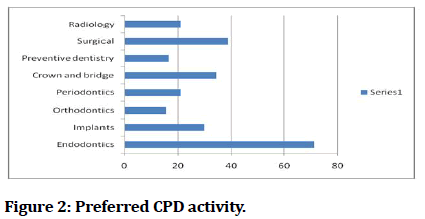Research - (2022) Volume 10, Issue 1
Continuing Professional Development: A Web Based Survey among Dentists of Latur
Vijayalaxmi1*, Varsha Sangle2, Tejashree Mantri1, Namratha Patil3 and Priyanka Lasune1
*Correspondence: Vijayalaxmi, Department of Oral Medicine and Radiology, MIDSR Dental College, India, Email:
Abstract
Aim: To assess the preferences of professionals regarding subject, time, cost, etc. as well to assess the awareness and encouragement to attend CPD among dentists of Latur city. Materials and Methods: A Google form of self-administered questions were inquired regarding awareness, 5 questions on personal interests, 2 questions on personal preferences and on speakers reputation as well. Results: 63% females and 37% males constituted the study. Only 87% participants were aware of CPD activities. Most preferred CPD activity was hands on and courses with 53 and 52% respectively. Endodontic was preferred at 66%. Time preferences were studied with 66% participants wanting to attend at weekends with 49% preferring morning sessions. 51.1% attended CPD irrespective for wanting of CDE points. For 95.7% participants speakers reputation mattered to attend CPD. Conclusion: Most of the participants are aware of CPD courses. Endodontic was most preferred. More than half of participants preferred to attend CPD courses at weekends and in morning.
Keywords
CPD, Endodontic, Dental practitioners, Google forms, Implantology
Introduction
Continuing Professional Development is autodriven with the thirst to upgrade ones profession to emerging trends. It is an ongoing process in one’s life, adding accrediation to an individual. This knowledge helps build academic and community sectors. The institute is directly benefitted by professional development of its teachers. CPD helps build ones confidence and personality. CPD ranges from Postgraduation to conferences to webinars. It encompasses a wide range of knowlegde through various platforms.
Professionals benefit from Continuing Professional Development:
• It helps broaden professional knowledge.
• It encompasses academic and professional activities.
• It helps to understand new emerging technologies.
• It helps build and maintain professional relationships.
• It boosts with advanced clinical skills and improve
treatment aspects.
• It helps build confidence in clinical skills.
• Helps in professional accrediation.
• Professional knowledge, clinical skills and treatment
splan are more competent and ethical based.
An effective CPD scheme should have three quality components1:
• Professional improvement that ensures personal
learning related to the populations’ changing needs
and developing healthcare service.
• Effective learning interventions should be designed
upon clear, attainable, and measurable learning
outcomes and offer relevant and evidence-based
content to the physician's clinical practice
• It must be accountable, transparent, amenable to
regulation, and useful for assuring quality in the
process of relicensure.
Material and Method
A survey of dental practitioners was conducted in Latur city of Maharashtra. A total of 90 dentists participated in this survey conducted online through Google forms. Ethical clearance was obtained from the Institutional Review Board. Self-administered questionnaire were prepared after going through review of literature. Personal and Professional data were obtained from individuals who participated in this survey. Personal data included name, age, gender, qualification and professional data included awareness of CPD activity, 5 questions on personal interests, 2 questions on personal preferences and on speakers reputation as well. First question was the preferred mode of learning, second question was the topic of interest for learning. The additional questions were regarding time to attend CPD activities like weekdays or weekends and morning/afternoon/evening. Did the cost factor or topic affected their attendance was studied. Questions about what encouraged to attend CPD like speakers reputation, topic were a few addition.
Statistical analysis
Percentage contribution of each of the variable was obtained. Association between frequencies of information obtained was assessed with Pearson’s Chi square test.
A total of 90 Dentists participated in this study. The mean age group for the whole study population was 33.88. Majority of the participants (58.89%) were in the age group of 31-40 years, followed by 22-30 yrs. (26.67%) and 41-45 yrs. (14.44%). The study comprised 56 females (62.22%) and 34 males (37.78%). As per the qualifications, 47 MDS (52.22%) and 43 BDS (47.78%) comprised the study group.
The awareness of Professional Development was seen among 86.67% (91.49% MDS and 81.40% BDS) with majority (52.22%) preferring Conferences, followed by Hands on live patients (48.89%) and simulated clinical situation (47.78%), least being On- Demand-Webinars (8.89%).
Majority (71.11%) of participants preferred Endodontics, 88.37% BDS qualified participants and 55.32% MDS. The order of preference of topics later was Surgical (38.89%), Crown and Bridge (34.44%), Implants (30%), Periodontics and Radiology (21.11%), Preventive Dentistry (16.67%) and Orthodontics (15.56%).
Factors which encouraged Dentists to attend CPD were studied, 89 (98.89%) participants out of 90 and 86 (95.56%) were encouraged by the topic and speakers reputation respectively to attend CPD. 46 (51.11%) participants attendance was independent of CDE points. On the contrary, 49 (54.44%) attended for Certificate or Degree provided.
The participants preferences in relation to time to conduct CPD’S were studied, 67.78% preferred weekends as compared to 32.22% preferred weekdays and 47.78% preferred morning sessions with least (24.44%) preferring evenings. The cost of CPD activity bothered 61.11% participants.
It was found that, there was significant correlation between academic degree and preferences of CPD activity with E-learning, on demand webinars and symposiums (0.0280, 0.0001 and 0.0001 respectively). Significant correlation was also found between topic of interest and academic degree with Endodontics and Surgical activities (0.001 and 0.009) and topic of interest and gender with Implants, 0.0230 respectively (Figures 1 and 2).

Figure 1: % of respondents.

Figure 2:Preferred CPD activity.
Discussion
Continuing Professional Development is self-driven with a sense of fulfilment and a desire to prosper one self. CPD reflects adult learning principles of autonomy, selfdirection, goal orientation, and practice-based learning [1]. Discussion with colleagues was a form to gain knowledge in 38.89%. Lectures and Hands-on were preferred choice after conferences showing lectures being effective and cost efficient. Lectures were acknowledged as a useful method and also an opportunity with meet up with colleagues in a study done by Barnes t al [2]. Hands-on helps to deliver hand skills along with knowledge. Study conducted by Chan et al [3] found participants requested for CPD in Oral Implantology, Cosmetic Dentistry and root canal therapy in contrast to our study where Endodontics (88.37% BDS & 71.11% MDS) followed by Surgical (53.49% BDS and 38.89% MDS) were preferred by participants holding undergraduate and postgraduate degree. Study conducted by Hopcraft et al. [4] had implantology (39%), endodontics (39%) and esthetic/cosmetic dentistry (37%) as preferred choice.
Our study showed endodontics as the first preferred topic as per academic degree and gender wise. Academic degree wise, the second preferred topic is crown and bridge for BDS graduates and implants for MDS participants. According to gender wise, females preferred surgical and male participants preferred implants as second choice. This showcases that CPD activities are preferred as per practical aspects to improve hand skills and knowledge. Study done by Nayak et al. [5] concluded that the preferred topics were aesthetic dentistry followed by endodontics and implantology.
Nayak et al. [5] also concluded that the preferred method of CPD were hands-on treatment on live patients and hands-on in the clinically simulated situation and our study saw hands-on live patients and hands-on clinical simulation as second preferred choice to conference.
Lack of time is well known barrier and thus in our study, the participants preferences to attend CPD were considered in our study. 67.78% preferred weekends and 47.78% preferred mornings to attend CPD. The topic played a key role to attend CPD in 98.89% with 95.56% encouraged by speaker’s reputation. On the contrary, 48.89% attendance was based on CDE points granted and 54.44% attended for certificate or degree provided.
The cost was definitely a barrier for 61.11% participants to attend CPD in our study. Majority of practitioners were neutral on the cost of CDE courses, whereas study conducted by Gabani et al. [6-8] the most common barrier was cost (82.1%) and time (53.6%).
Conclusion
CPD assessment should provide information on whether: Target audience needs were addressed, Learning objectives were met, Participants were engaged and Behaviour changes were achieved.
Assessment closes the CPD cycle and involves two components: Reinforcement or finding opportunities in clinical practice to apply new knowledge and skills. Dissemination of new learning to colleagues at practice settings (e.g., rounds, clinical meetings, and unplanned moments during clinical practice)
Accreditation: CPD must be amenable to external evaluation to become transparent, demonstrable, and accountable. If consistently planned, undertaken, and recorded; CPD can be assessed. Ideally always as a selfassessment including regular discussions with peers or a formal examination. More than a process to meet accreditation requirements or to be credit awarded, assessment should be envisioned as a higher value to bring effectiveness to learning.
In the present study, conventional methods such as discussion with colleagues, lectures, courses, hands–on are still given more importance as well as growing interest in modern information technologies with internet usage as a mode of learning. Our study is consistent with the findings from previous studies.3
References
- Filipe HP, Silva ED, Stulting AA, et al. Continuing professional development: Best practices. Middle East Afr J Ophthalmol 2014; 21:134.
- Barnes E, Bullock AD, Bailey SE, et al. A review of continuing professional development for dentists in Europe. Eur J Dent Educ 2013; 17:5-17.
- Chan WC, Ng CH, Yiu BK, et al. A survey on the preference for continuing professional dental education amongst general dental practitioners who attended the 26th Asia Pacific Dental Congress. Eur J Dent Educ 2006; 10:210-6.
- Hopcraft MS, Marks G, Manton DJ. Participation in continuing professional development by Victorian dental practitioners in 2004. Aust Dent J 2008; 53:133-9.
- Nayak PP, Prasad KV, Jyothi C, et al. Preferences and barriers for continuing professional development among dental practitioners in the twin cities of Hubli-Dharwad, India. J Indian Assoc Public Health Dent 2015; 13:429.
- Gabani WO. Continuing professional development (CPD): Participation and perception among practicing dentists in the public sector in Khartoum state–Sudan 2018. Global J Med Public Health 2019; 8:1-8.
- Nayak PP, Rao NS, Ali AK, et al. Keeping up with dental literature: A study on continuing professional development among dental practitioners in Hubli-Dharwad, India. J Clin Diagnostic Res 2017; 11:ZC27.
- Nieri M, Mauro S. Continuing professional development of dental practitioners in Prato, Italy. J Dent Educ 2008; 72:616-25.
Indexed at, Google Scholar, Cross Ref
Indexed at, Google Scholar, Cross Ref
Indexed at, Google Scholar, Cross Ref
Indexed at, Google Scholar, Cross Ref
Indexed at, Google Scholar, Cross Ref
Indexed at, Google Scholar, Cross Ref
Author Info
Vijayalaxmi1*, Varsha Sangle2, Tejashree Mantri1, Namratha Patil3 and Priyanka Lasune1
1Department of Oral Medicine and Radiology, MIDSR Dental College, India2Department of Oral Pathology, MIDSR Dental College, India
3Department of Oral Medicine and Radiology, KLE Institute of Dental Sciences, Belgavi, India
Citation: Vijayalaxmi, Varsha Sangle, Tejashree Mantri, Namratha Patil, Priyanka Lasune,Continuing Professional Development: A Web Based Survey among Dentists of Latur, J Res Med Dent Sci, 2022, 10(1): 441-444
Received: 10-Dec-2021, Manuscript No. Jrmds-21-41039; , Pre QC No. Jrmds-21-41039 (PQ); Editor assigned: 13-Jan-2021, Pre QC No. Jrmds-21-41039 (PQ); Reviewed: 27-Dec-2021, QC No. Jrmds-21-41039; Revised: 30-Dec-2021, Manuscript No. Jrmds-21-41039 (R); Published: 06-Jan-2022
